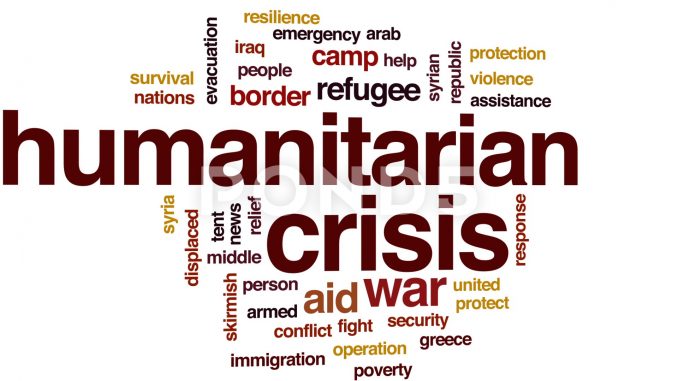
Table of Contents
What is Humanitarian Emergency?
- A humanitarian emergency is an event or series of events that represent a critical threat to the health, safety, security or wellbeing of a community or other large group of people, usually over a wide area.
- Large number of the people are affected and face various problems due to this situation.
- During humanitarian emergencies, many people die or are displaced, their livelihood are displaced and they are forced to face disease and hunger.
Categories of Humanitarian Emergencies:
Humanitarian Emergencies can be grouped into following categories:
- Humanitarian emergencies due to natural disasters: caused due to disasters such as tsunami, earthquake, cyclones or biological epidemics (e.g.: plague)
- Man-made emergencies, such as armed conflicts, plane and train crashes, fires, industrial accidents etc.
- Complex humanitarian emergencies, which often have a combination of natural and man-made elements, and different causes of vulnerability and a combination of factors that lead to a humanitarian crisis.
Complex humanitarian emergencies have 3 main features:
- Multidimensional phenomenon, not only wars but addition of other forms including migration, hunger and disease
- In many instances, when complex humanitarian emergencies are/seem manmade, natural phenomenon can be a real trigger.
- They are essentially political and politicized crisis.
Examples of different humanitarian emergencies:
- Two decades of civil conflict in Somalia
- Syrian refugee crisis
- Nepal earthquake (April 25, 2015)
- Ebola outbreaks
- South Sudan conflict and hunger
Consequences of humanitarian emergencies:
1. Direct impacts
- Death (mortality and morbidity)
- Psychological disorders which are bound to increase in people
- Loss of lives and infrastructures
- Agricultural and financial loss
- Emergence of new diseases
- Increase chances of epidemics
2. Indirect impacts
- Population displacement
- Difficulty in coping with morbidity and disability
- Post-Traumatic Stress Disorders (PTSD)
- Poverty
- Rise in hunger and starvation, specially in severely affected and hard-to-reach areas
- Rise in violence, reproductive health problems
- Increase in cases on acute malnutrition, food shortages, etc.
Effects of humanitarian emergencies on food and nutrition:
- Hunger and malnutrition are very common during humanitarian crisis
- People endure hardship physically, mentally and financially during such crisis
- Their livelihood is damaged and are completely abandoned
- Poor access and availability to safe drinking water
- Limited supply of food
- People are more injured or sick and need highly nutritious foods to overcome such state
- Emotional stress, chaotic environment makes it unnecessary and unsuitable to prepare meal or to even have meal
- Specially, the most vulnerable populations like Pregnant and Lactating Women (PLWs), children under five years of age and elder citizens are severely affected. Their health, nutrition and mental state is broadly and deeply affected
Ways to overcome the poor food and nutrition status during humanitarian emergencies:
1. Before Crisis
1.1 Preparedness
- Humanitarian emergencies are best tackled by preparedness
- Preparedness should be done keeping an eye for different possible disasters
- Preparedness include risk assessment, planning, stockpiling of equipment and supplies, emergency services and stand-by arrangements.
- It also refers to proper communication, information management and coordination arrangements between various agencies involved during emergencies.
2. During/After the crisis
2.1 Food distribution
- It is necessary to ensure that the food provided during humanitarian emergencies are nutritionally appropriate, addresses context-specific problems, and meets minimum energy, protein and fat requirements for survival and light physical activity.
- We also need to ensure that the food distributed during humanitarian emergencies reaches the people most in need.
- Food distribution should be equitable i.e. need based.
- Along with the food distribution, targeted food supplementation can also be done for most vulnerable populations like Pregnant and Lactating Women (PLWs) and children under five years of age.
- Steps to support local farmers and businesses should be taken as much as possible
- Regular monitoring needs to be done at affected places to ensure proper food distribution.
2.2 Situation assessment
- After the emergency, situation assessment of the requirement of the food and nutrition must be done by the concerned authorities
- These food requirements then need to be fulfilled immediately without any delay by the state or other supporting agencies
- Such assessment would help in proper distribution of the food aid at all places
Challenges before and after humanitarian emergencies:
- Getting the right foods at the right time to the right people is most challenging. Specially reaching to hard-to-reach areas and the most vulnerable ones is even challenging.
- Preparing and dealing with mental health problems and disorders like trauma (Post-Traumatic Stress Disorders), distress etc., which may increase in the affected areas.
- Providing proper support, counselling, care and possible rehabilitation facilities to affected populations.
- Maintaining good sanitation, safe drinking water, and other supplies due to disrupted water and sanitation pipes and contaminated sources of water.
References and for More Information:
http://www.who.int/environmental_health_emergencies/complex_emergencies/en/
https://www.humanitariancoalition.ca/what-is-a-humanitarian-emergency
https://www.unfpa.org/emergencies
https://www.worldvision.org/disaster-relief-news-stories/top-humanitarian-crises-2015
https://www.irinnews.org/feature/2018/01/01/ten-humanitarian-crises-look-out-2018
https://www.futurelearn.com/courses/health-crises/0/steps/22887
https://www.ncbi.nlm.nih.gov/pmc/articles/PMC5706345/
http://www.who.int/hac/techguidance/tools/manuals/who_field_handbook/annex_2/en/
https://www.ncbi.nlm.nih.gov/pmc/articles/PMC4910127/
https://www.humanitariancoalition.ca/food-and-nutrition-in-emergencies
http://www.who.int/nutrition/topics/emergencies/en/
https://www.coursera.org/lecture/humanitarian-public-health/nutrition-in-humanitarian-crises-pxoTO (video)
http://journals.sagepub.com/doi/pdf/10.1177/156482650602700109